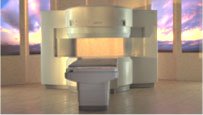 | Info
Sheets |
| | | | | | | | | | | | | | | | | | | | | | | | |
 | Out-
side |
| | | | |
|
| | | | | |  | Searchterm 'Phase' was also found in the following services: | | | | |
|  |  |
| |
|

From Hitachi Medical Systems America Inc.;
the AIRIS II, an entry in the diagnostic category of open MR systems, was designed by Hitachi
Medical Systems America Inc. (Twinsburg, OH, USA) and Hitachi Medical Corp. (Tokyo) and is manufactured by the Tokyo branch. A 0.3 T field-strength magnet and phased array coils deliver high image quality without the need for a tunnel-type high-field system, thereby significantly improving patient comfort not only for claustrophobic patients.
Device Information and Specification
CLINICAL APPLICATION
Whole body
QD Head, MA Head and Neck, QD C-Spine, MA or QD Shoulder, MA CTL Spine, QD Knee, Neck, QD TMJ, QD Breast, QD Flex Body (4 sizes), Small and Large Extrem., QD Wrist, MA Foot and Ankle (WIP), PVA (WIP)
SE, GE, GR, IR, FIR, STIR, FSE, ss-FSE, FLAIR, EPI -DWI, SE-EPI, ms - EPI, SSP, MTC, SARGE, RSSG, TRSG, MRCP, Angiography: CE, 2D/3D TOF
IMAGING MODES
Single, multislice, volume study
TR
SE: 30 - 10,000msec GE: 20 - 10,000msec IR: 50 - 16,700msec FSE: 200 - 16,7000msec
TE
SE : 10 - 250msec IR: 10 -250msec GE: 5 - 50 msec FSE: 15 - 2,000
0.05 sec/image (256 x 256)
2D: 2 - 100 mm; 3D: 0.5 - 5 mm
Level Range: -2,000 to +4,000
POWER REQUIREMENTS
208/220/240 V, single phase
COOLING SYSTEM TYPE
Air-cooled
2.0 m lateral, 2.5 m vert./long
| |  | | | | | | | | |
|  |  | Searchterm 'Phase' was also found in the following services: | | | | |
|  |  |
| |
|
| |  | |
• View the DATABASE results for 'Acquisition Matrix' (12).
| | | | |
|  | |  |  |  |
| |
|
This family of sequences uses a balanced gradient waveform. This waveform will act on any stationary spin on resonance between 2 consecutive RF pulses and return it to the same phase it had before the gradients were applied.
A balanced sequence starts out with a RF pulse of 90° or less and the spins in the steady state. Prior to the next TR in the slice encoding, the phase encoding and the frequency encoding direction, gradients are balanced so their net value is zero. Now the spins are prepared to accept the next RF pulse, and their corresponding signal can become part of the new transverse magnetization. If the balanced gradients maintain the longitudinal and transverse magnetization, the result is that both T1 and T2 contrast
are represented in the image.
This pulse sequence produces images with increased signal from fluid (like T2 weighted sequences), along with retaining T1 weighted tissue contrast. Balanced sequences are particularly useful in cardiac MRI. Because this form of sequence is extremely dependent on field homogeneity, it is essential to run a shimming prior the acquisition.
Usually the gray and white matter contrast is poor, making this type of sequence unsuited for brain MRI. Modifications like ramping up and down the flip angles can increase signal to noise ratio and contrast of brain tissues (suggested under the name COSMIC - Coherent Oscillatory State acquisition for the Manipulation of Image Contrast).
These sequences include e.g. Balanced Fast Field Echo (bFFE), Balanced Turbo Field Echo ( bTFE), Fast Imaging with Steady Precession ( TrueFISP, sometimes short TRUFI), Completely Balanced Steady State (CBASS) and Balanced SARGE (BASG). | | | |  | |
• View the DATABASE results for 'Balanced Sequence' (5).
| | | | |  Further Reading: Further Reading: | News & More:
|
|
| |
|  |  | Searchterm 'Phase' was also found in the following services: | | | | |
|  |  |
| |
|
Burst pulse sequences are fast imaging sequences capable of image acquisition in less than 100 ms.
Basically a train of low flip angle pulses generates a long train of echoes. The complete sequence is performed with the application of a constant read gradient. Phase encoding may be implemented using short phase encoding gradients between echoes.
The advantage of this sequence type is that it is less demanding on gradient speed than other fast techniques (e.g. echo planar imaging EPI) and it produces images, which are substantially free of susceptibility artifacts.
The disadvantage is that the technique is less sensitive than competing methods. | |  | | | |
|  |  | Searchterm 'Phase' was also found in the following services: | | | | |
|  |  |
| |
|
| | | |  | |
• View the DATABASE results for 'Carr Purcell Meiboom Gill Sequence' (2).
| | | | |  Further Reading: Further Reading: | | Basics:
|
|
News & More:
| |
| |
|  | |  |  |
|  | |
|  | | |
|
| |
 | Look
Ups |
| |